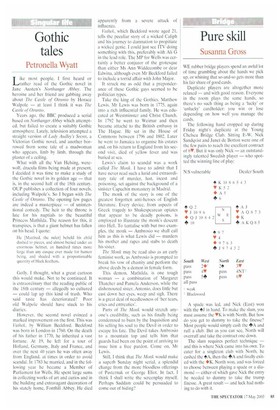Gothic tales
PetroneIla Wyatt
Tike most people, I first heard or , rather read of the Gothic novel in Jane Austen's Northanger Abbey. The heroine and her friend are gabbing away about The Castle of Otranto by Horace Walpole — at least I think it was The Castle of Otranto.
Years ago, the BBC produced a serial based on Northanger Abbey which attempted, but failed to create a suitably Gothic atmosphere. Lately, television attempted a straight version of Lady Audley's Secret, a Victorian Gothic novel, and another borrowed from some tale of a madwoman who appears, limb by limb, through the plaster of a ceiling.
What with all the Van Helsing, werewolf, dracula films being made at present, I decided it was time to make a study of the Gothic novel in its golden age — that is, in the second half of the 18th century. OUP publishes a collection of four novels, including Walpole's. So I began with The Castle of Otranto. The opening few pages are indeed a masterpiece — of unintentional comedy. The heir to the throne is late for his nuptials to the beautiful Princess Mathilda. The reason for this, it transpires, is that a giant helmet has fallen on his head. I quote:
He [Manfred. the ruler} beheld his child dashed to pieces, and almost buried under an enormous helmet, an hundred times more large than any casque ever made for human being. and shaded with a proportionable quantity of black feathers.
Golly, I thought, what a great cartoon this would make. Not to be continued. It is extraordinary that the reading public of the 18th century — allegedly so cultured — could lap up this kind of trash. Who said taste has deteriorated? Poor old Walpole should have stuck to his diaries.
However, the second novel evinced a marked improvement on the first. This was Vathek, by William Beckford. Beckford was born in London in 1760. On the death of his father in 1770, he inherited a vast fortune. At 19, he left for a tour of Holland, Germany, Italy and France, and over the next 40 years he was often away from England, at times in order to avoid scandal. In 1783 he married, and in the following year he became a Member of Parliament for Wells. He spent large sums in collecting works of art and curios and in the building and extravagant decoration of his stately home, Fonthill Abbey. He died
apparently from a severe attack of influenza.
Vathek, which Beckford wrote aged 21, tells the peculiar story of a wicked Caliph and his journey to damnation to propitiate a wicked genie. I could just see ITV doing something with this, preferably with Ali G in the lead role, The MP for Wells was certainly a better conjuror of the grotesque than either Ms Ann Widdecombe or dear Edwina, although even Mr Beckford failed to include a torrid affair with John Major.
It struck me as odd that a preponderance of these Gothic guys seemed to be politician types.
Take the king of the Gothics, Matthew Lewis. Mr Lewis was born in 1775, again into a rich influential family. He was educated at Westminster and Christ Church. In 1792 he went to Weimar and then became attache to the British embassy in The Hague. He sat in the House of Commons between 1796 and 1802. Later he went to Jamaica to organise his estates and, on his return to England from his second visit, died of yellow fever and was buried at sea.
Lewis's claim to scandal was a work called The Monk. I have to admit that I have never read such a lurid and extraordinary talc of murder, lust, incest and poisoning, set against the background of a sinister Capuchin monastery in Madrid.
The monk of the story is one of the greatest forgotten anti-heroes of English literature. Every device, from aspects of Greek tragedy to Shakespearean opiates that appear to be deadly poisons, is employed to illustrate the monk's descent into Hell. To tantalise with hut two examples, the monk — Ambrosio we shall call him as this is what Lewis did — murders his mother and rapes and stabs to death his sister.
The Monk may be read also as an early feminist work, as Ambrosio is prompted to break his vow of chastity and perform the above deeds by a demon in female form.
This demon, Mathilda, is one tough woman — a combination of Margaret Thatcher and Pamela Anderson, while the dishonoured sister, Antonio, does little but cast down her eyes, weep and sigh. There is a great deal of needlessness of her tears, cries and entreaties'.
Parts of The Monk would stretch anyone's credibility, such as his finally being condemned to burn by the Inquisition and his selling his soul to the Devil in order to escape his fate. The Devil takes Ambrosio to a mountain top and tells him that guards had been on the point of arriving to issue him a free pardon. Come on, Mr Lewis.
Still, I think that The Monk would make a superb Sunday night serial, a splendid change from the more bloodless offerings of Pasternak or George Eliot. In fact, I think I shall write the screenplay myself. Perhaps Saddam could be persuaded to come out of hiding?


































































































 Previous page
Previous page